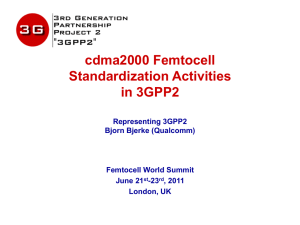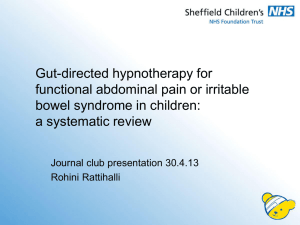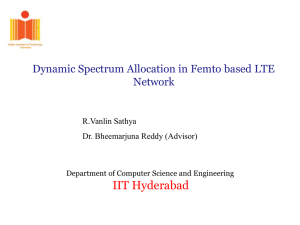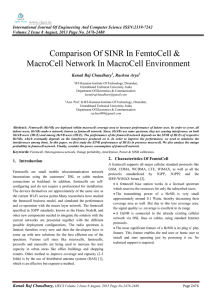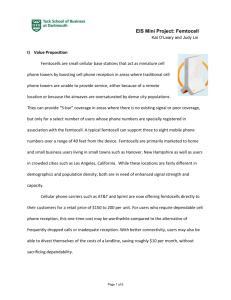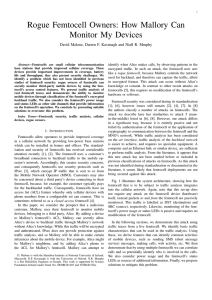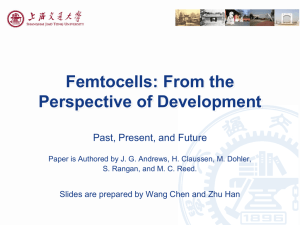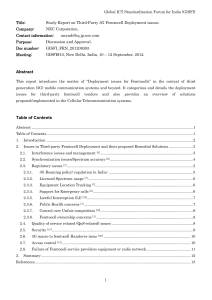f - CWiND
advertisement
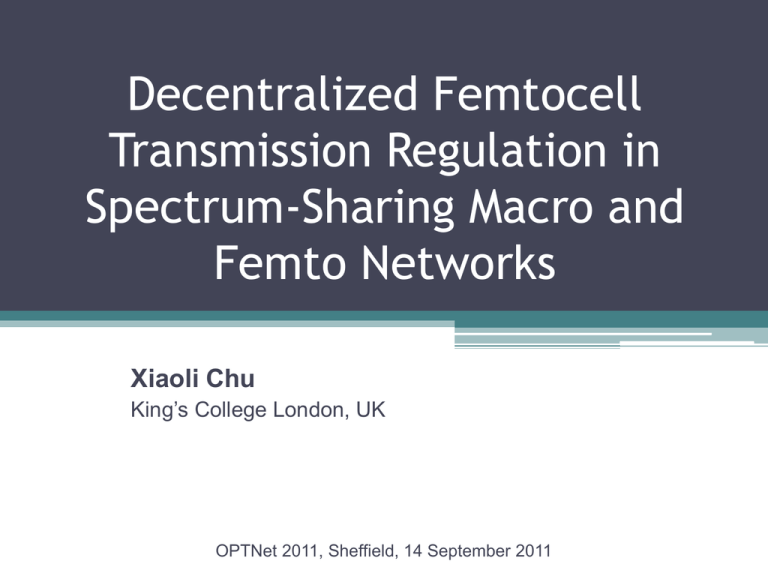
Decentralized Femtocell
Transmission Regulation in
Spectrum-Sharing Macro and
Femto Networks
Xiaoli Chu
King’s College London, UK
OPTNet 2011, Sheffield, 14 September 2011
Outline
• Introduction
• Collocated spectrum-sharing macro and femto cells
▫
▫
▫
▫
▫
Motivation
Contribution
System model
Outage probability analysis
Femtocell location and transmit power
• Simulation results
▫ Analytical results verified by simulations
• Conclusion
-2-
Introduction
Business opportunities
New markets
New user terminals
-4-
New applications
Technical challenges
• Current 2G and 3G
networks will not be
able to meet future
mobile data traffic
demands
• Most of the data traffic
is performed indoors,
where coverage is the
worst
• As a result, vendors
and operators are
desperately looking for
new solutions
Cisco Visual Networking Index: Global Mobile
Data Traffic Forecast Update, 2010–2015
-5-
Solutions: Femtocells
• Femtocells are low-power wireless access points (FAPs) that
operate in licensed spectrum to connect standard mobile
devices to a mobile operator’s network using residential DSL or
cable broadband connections [Source: Femto Forum].
▫ Improve indoor coverage
▫ Unload traffic from overburdened macrocells
▫ Likely to be user-deployed
-6-
Collocated Spectrum-Sharing
Macro and Femto Cells
Motivation
• Spectrum-sharing macro and femto cells
▫ Benefits Spectrum-sharing allows for increased spectral
efficiency and better spatial reuse
▫ Challenges Spectrum-sharing suffers from inter-cell
interference and creates dead spots where UE QoS cannot be
guaranteed.
-8-
Contribution
• Analysis of downlink (DL) outage probabilities (OPs)
▫ Closed-form macro and femto DL OP lower bounds embracing
the randomness of transmit power employed by different
interfering FAPs.
• Analysis includes both Rayleigh flat fading and shadowing
▫ Our work accounts for path loss, Rayleigh fading, lognormal (LN)
shadowing, and LN interfering FAP power, and allows different DL
(SIR) targets and OP constraints for macro and femto cells.
• Decentralized resource allocation
▫ Decentralized strategy to regulate FAP’s transmit power and
usage of radio resources to guarantee a satisfactory macro and
femto DL coverage.
-9-
System Model
• OFDMA downlink of collocated spectrum-sharing
macrocell and closed-access femtocells
rM
▫ A central MBS covers a disc area with radius rM
Macro coverage
circle
▫ Femtocells of radius rF are randomly distributed on R2 as a
spatial Poisson point process (SPPP) with a density of F.
▫ NF femtocells per cell site on average
MBS
PM,Tx
Femto coverage
circle
▫ MBS transmit power PM,Tx is evenly distributed among RBs
FAP
MUE
▫ UF indoor UEs per femtocell, each located on femtocell edge
rF
PF,Tx
FUE
▫ FAP transmit power PF,Tx is evenly distributed among RBs
▫ Each FAP transmits with a probability within an RB.
▫ Spatial intensity of co-channel FAPs is uF = F.
▫ Macro-to-macro interference and thermal noise are ignored.
R2
- 10 -
Channel Model
• Path loss follows the IMT-2000 channel model
• fc is the carrier frequency in MHz, d is the distance of the link,
and denotes the wall-penetration loss.
• Each frequency subchannel sees Rayleigh flat fading and
lognormal shadowing
- 11 -
Femtocell DL SIR
• The received SIR of an indoor FUE at the femtocell edge
PFF1H FQF rF F
SIR F
FM
FF
1
1
PMFM
H FM QFM DFM
PFFF
H FFi QFFi DFF
i
i
macro intef
femto intef
▫ PF = PF,TxGFAPGUE, PM = PM,TxGMBSGUE;
▫ DFM is the distance from the MBS to the FUE, DFFi is the distance
from interfering FAP i to the FUE;
▫ HF, HFM and HFFi are unit-mean exponential channel power gains;
▫ QF ~ LN(F, 2F2), QFM ~ LN(FM, 2FM2) and QFFi ~ LN(FF, 2FF2)
denote lognormal shadowing, = 0.1ln10;
▫ is the set of FAPs having access to the given RB, with intensity uF.
- 12 -
Femto Outage Probability
• Outage probability of an indoor FUE w.r.t. the target SIR F
SF
SF
SF
PSIR F F P
P
P
SIR
,
F
F
F
F
F
I
FF
1
I
I
P
H
Q
D
FM
FM
FM F FF FF i FF i FF i
i
Prob of macro-to-femto
interf. being strong enough to
create outage
Prob of femto-to-femto
and macro-to-femto
interf. causing outage
• For an indoor FUE at a distance dFM from the MBS
• Based on the stochastic geometry theory
PSIR F F DFM
PMF rF F F ~
2
d FM F
; F ~FM , ~F2 ~FM
P d FM
F FM FM
2 an 2 ~ bm ~F F
wn vm 1 exp Fu F e
Fe
N M
~
n 1m 1
2 an ~bm e bm
- 13 -
2~
FM bm FM
2
FF
Macrocell DL SIR
• The received SIR of an outdoor MUE is
PMM1H M QM DM M
SIR M
MF
1
P
H
Q
D
F MF MFi MFi MFi
i
femto intef
▫ DM is the distance from the MBS to the MUE, DMFi is the distance from
FAP i to the MUE;
▫ HM and HMFi denote unit-mean exponential channel power gains;
▫ QM ~ LN(M, 2M2) and QMFi ~ LN(MF, 2MF2) denote lognormal
shadowing.
- 14 -
Macro Outage Probability
• Outage probability of an MUE w.r.t. the target SIR M
SM
PSIR M M P
M
MF
1
PFMF H MFi QMFi DMFi
i
• For an MUE at a distance dM from the MBS
• Based on the stochastic geometry theory
PSIR M M DM d M 1
M
m1
2 2~Mbm 2 M
exp MuF exp
MF
MF
vm
2
2
PF M MF
2~MF 2~MF
exp
M
2
MF
MF
MF
- 15 -
Minimum MBS-to-FAP Distance
• P(SIRF < F) ≤ F and P(SIRM < M) ≤ M, where 0 ≤ F, M < 1
• P(SF/IFM < F|DFM = dFM) is a monotonically decreasing function of dFM.
• Minimum dFM required for P(SIRF < F|DFM = dFM) ≤ F
d FM, min
P F 1 ; ~ ~ , ~ 2 ~ 2
F
FM
F FM F F FFM
PMF rF F
1
FM
▫ = HFQF/(HFMQFM) approximately follows a LN
distribution
rM
MBS
• Any UE located less than dFM,min from the MBS
should be associated with the macrocell.
- 16 -
dFM,min
FAP
rF
FUE
FAP Transmit Power
• Femtocells’ transmit power should be within the range
[PF,Tx,min, PF,Tx,max]
• PF,Tx,max is delimited by network standard.
• PF,Tx,min is chosen as the minimum PF,Tx that makes an FUE
at the macrocell edge meet Pr(SF/IFM<F|DFM= rM) ≤F.
PF, Tx,min
PM, Tx GMBSF rF F F
2
GFAP FM rM FM F1 F ; ~F ~FM , ~F2 ~FM
where F1 F ; ~F ~FM ,
evaluated at F.
2
~F2 ~FM
is the inverse CDF of the LN RV
- 17 -
FAP Self-Regulation
• FAP at a distance d (dFM,min ≤ d ≤ rM) from the MBS,
▫ For an RB, if P(LB)F,Tx(d) min{P(UB)F,Tx(d), PF,Tx,max}, then the FAP
can transmit in the RB with PF,Tx set in the range [P(LB)F,Tx(d),
min{P(UB)F,Tx(d), PF,Tx,max}] for simultaneously meeting both the
macro and femto DL OP constraints;
P LB d
F, Tx
PM, TxGMBSFrF F F
2
GFAP FM d FM F1 F ; ~F ~FM , ~F2 ~FM
▫ otherwise, the FAP can only transmit in the RB with P(LB)F,Tx(d)
and at a reduced probability.
2
2 UB
UB
P
r
PF, Tx,max
PF, Tx,max rM dBm PF, Tx,max dBm
F, Tx,max M dBm
2
18 MF
MF
exp
2 P
UB
F, Tx, min dBm PF, Tx, max rM dBm PF, Tx, max dBm
2
9 MF
- 18 -
2
dBm
Simulations and Results
Simulation Setup
• FAPs and MUEs are randomly dropped within the macrocell
coverage, following two independent SPPPs.
Parameters
Values
Parameters
Values
10 dB, 15 dB
PM,Tx
43 dBm
M, FM
4
PF,Tx
23 dBm
F
3
GMBS
15 dBi
FF, MF
3.5
GFAP
2 dBi
M
8 dB
GUE
0 dBi
F
4 dB
rM
1000 m
FF
12 dB
rF
30 m
MF, FM
10 dB
UF
2
fc
2000 MHz
M
5 dB
M, F
0.1
F
10 dB
- 20 -
Outage Probability
• DL OP vs. the distance from the MBS, for NF = 30 and 100, = 10 dB.
- 21 -
Performance of Femto Self Reg
• Simulated DL OP vs. the distance from the MBS, when the femtocell
regulation strategy is employed at each FAP.
- 22 -
Femto Self Reg
• FAP transmit power and vs. the distance from the MBS, when using
the proposed femtocell regulation strategy.
- 23 -
Conclusions
• OFDMA downlink of collocated spectrum-sharing
macrocell and closed-access femtocells
▫ Closed-form analytical expressions for outage probabilities
▫ Analytical expression of minimum MBS-to-FAP distance
▫ Simulation results have verified the accuracy of analytical
results.
• Interference caused by femtocells has to be limited by
▫ regulating femtocell transmit power, which depends on the
distance from the MBS; or
▫ restricting the probability of each femtocell transmitting in
each RB, which can be controlled in both frequency and time
domains.
- 24 -
Further Information
• This research has been supported by the UK EPSRC Grants
EP/H020268/1, CASE/CNA/07/106, and the RCUK UKChina Science Bridges Project (EP/G042713/1): R&D on
(B)4G Wireless Mobile Communications.
• Related publications and submissions:
▫ X. Chu, Y. Wu, D. López-Pérez and H. Wang, “Decentralized femtocell transmission
regulation in spectrum-sharing macro and femto networks,” IEEE VTC 2011-Fall,
San Francisco, USA, Sep 2011.
▫ X. Chu, Y. Wu and H. Wang, “Outage probability analysis for collocated spectrumsharing macrocell and femtocells,” IEEE ICC 2011, Kyoto, Japan, Jun 2011.
▫ X. Chu, Y. Wu, L. Benmesbah and W. K. Ling, “Resource allocation in hybrid
macro/femto networks,” IEEE WCNC 2010 WS, Sydney, Australia, Apr 2010.
▫ X. Chu, Y. Wu, D. López-Pérez and X. Tao, “On providing downlink services in
collocated spectrum-sharing macro and femto networks,” IEEE Trans. Wireless
Commun., under review.
- 25 -
Thank You !
Xiaoli Chu
xiaoli.chu@kcl.ac.uk
- 26 -

